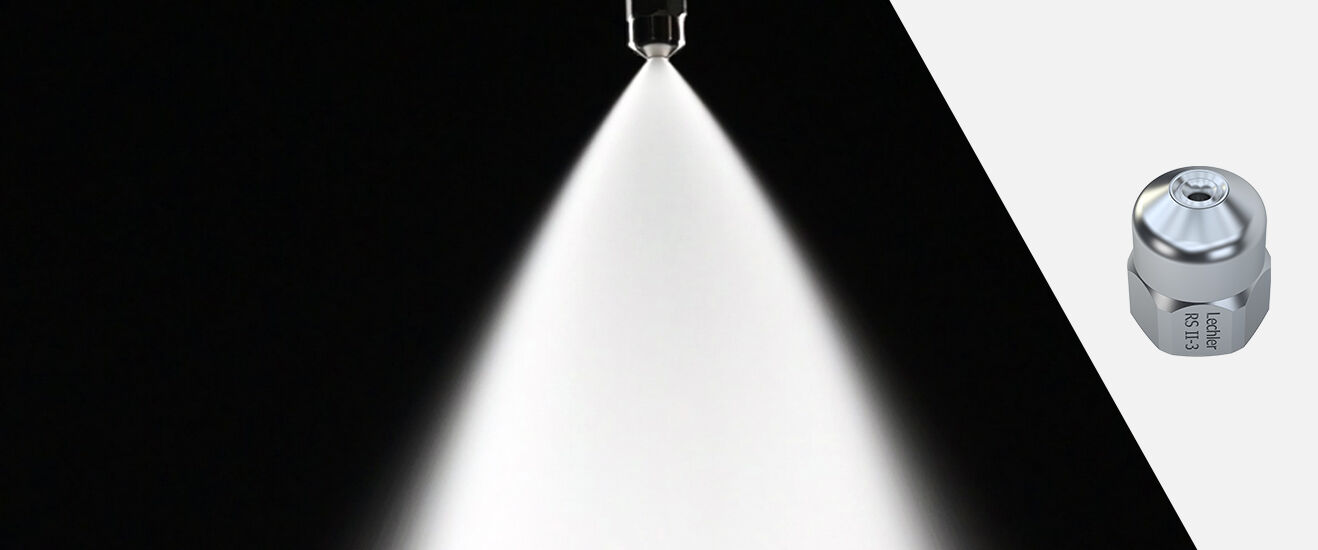RS II-3 spillback nozzle – The new generation for finest atomization without compressed air
The RS II-3 spillback nozzle convinces with even finer droplets for shortest evaporation distances, optimized design and a high flow rate control range. Compared to conventional spillback flow nozzles, a reduction of the required evaporation distance by up to 50% can be achieved.

Operating principle
Spillback nozzles are single-fluid nozzles that atomize the liquid as a hollow cone. In comparison to conventional single-fluid nozzles, however, the water is fed to the nozzle at a constant feed pressure (e.g. 35 bar), independent of the atomized flow rate.
By opening a control valve in the return line, a partial flow of the flow volume flow in the nozzle is returned to the water tank and the injection quantity of the nozzle is controlled. The maximum atomized flow rate is achieved with the control valve closed. Uniform and fine liquid atomization is achieved over the entire control range.

Spillback closed, spray angle approx. 80 - 85° (left) and spillback open, spray angle approx. 100° (right)
Advantages of the RS II-3 spillback nozzle
- Low operating costs, as no atomizing air is required
- Large turn-down ratio of min. 10:1
- Constant drop size over the entire control range
Case study: RS II-3 spillback nozzles in a cement plant
An optimized droplet size is very important for the design of gas cooling systems such as those used in cement plants. The smaller the injected droplets, the shorter evaporation distances can be realized.
Especially in large evaporative coolers, where large quantities of water are required for operation, spillback nozzles are often used. In this case, twin-fluid nozzles would increase the operating costs noticeably due to the additional compressed air consumption.
In the past, however, twin-fluid nozzles were often the only possible choice when short evaporation distances or system upgrades after increasing capacity were required.
This is no longer the case with the new RS II-3 series spillback nozzles. With their considerably finer droplet spectrum, the new generation of spillback nozzles can be used as an alternative to twin-fluid nozzles.
Successful increase in efficiency through Lechler spillback nozzles
Lechler has carried out the replacement of nozzle lances in an existing system at a cement plant in Northern Europe (Norway). Up to now, cooling to 160 °C was achieved at best in the evaporative cooler of the Norwegian cement plant. In addition, the problems of incomplete evaporation and wet bottom occurred.
By replacing the existing 16 nozzle lances with nozzle lances with RS II-3 it is now possible to cool down to 130 °C, which means an enormous increase in efficiency. The finer droplets also allow complete evaporation, thus eliminating the problem of wet soil.
Mounting and dismounting of the spillback nozzle on the lance is quick and easy, so that no cost-intensive maintenance times are required in the future.
Increase efficiency – use potential
Are you also interested in improving the performance of your evaporative cooler? By replacing the existing nozzle lances with our new generation of spillback nozzles, a reduction of the evaporation distance or a more efficient gas cooling can be achieved.
Besides the droplet size, other parameters play an important role:
- optimal distribution of the injected water quantity over the cross-section of the evaporative cooler
- Optimization of the gas flow e.g. through perforated or baffle plates
With simulations by means of CFD (Computational Fluid Dynamics) Lechler shows you the intelligent way to the optimal nozzle allocation and supports you to use the potential of your evaporative cooler optimally.